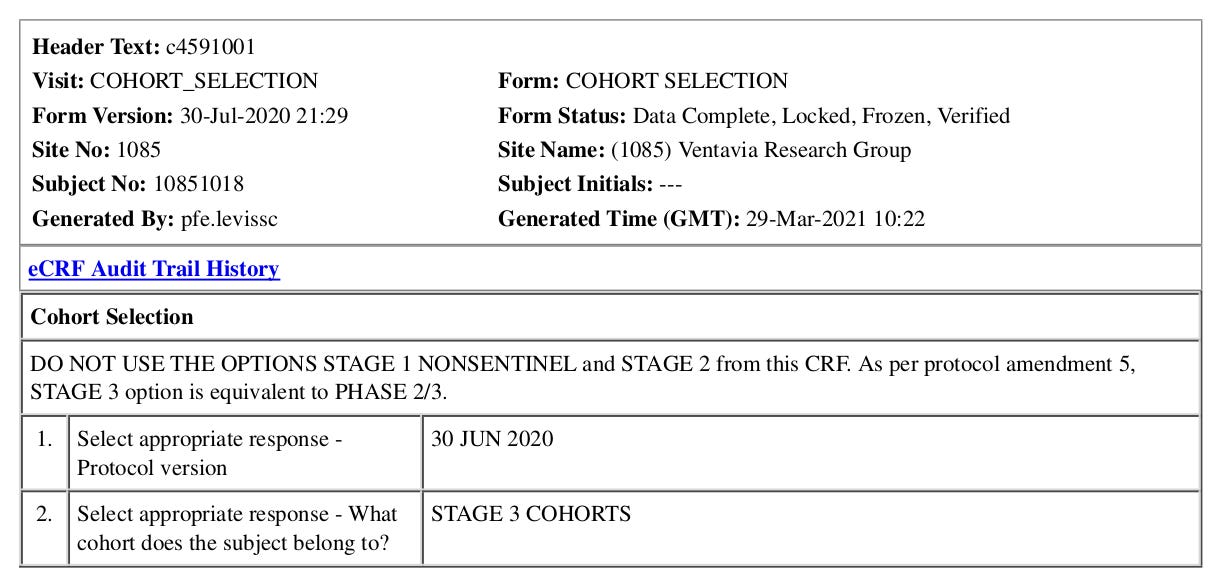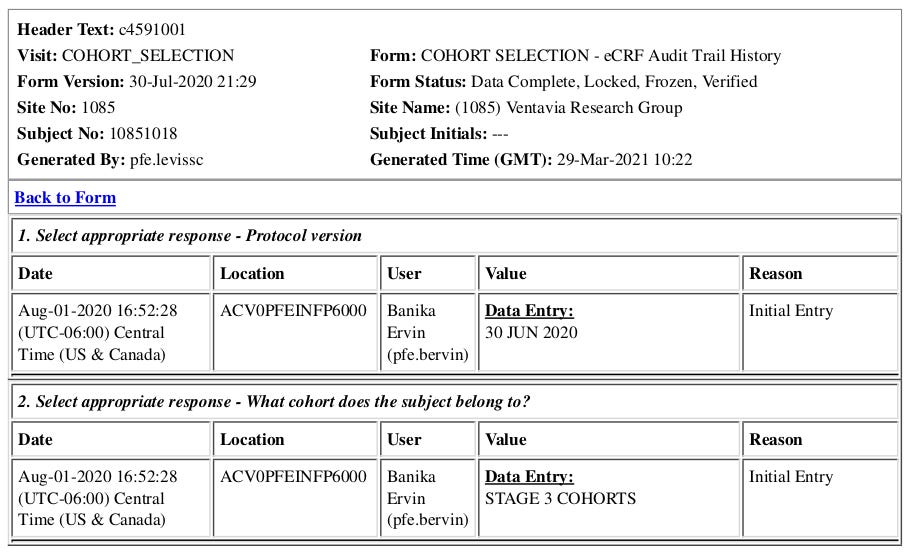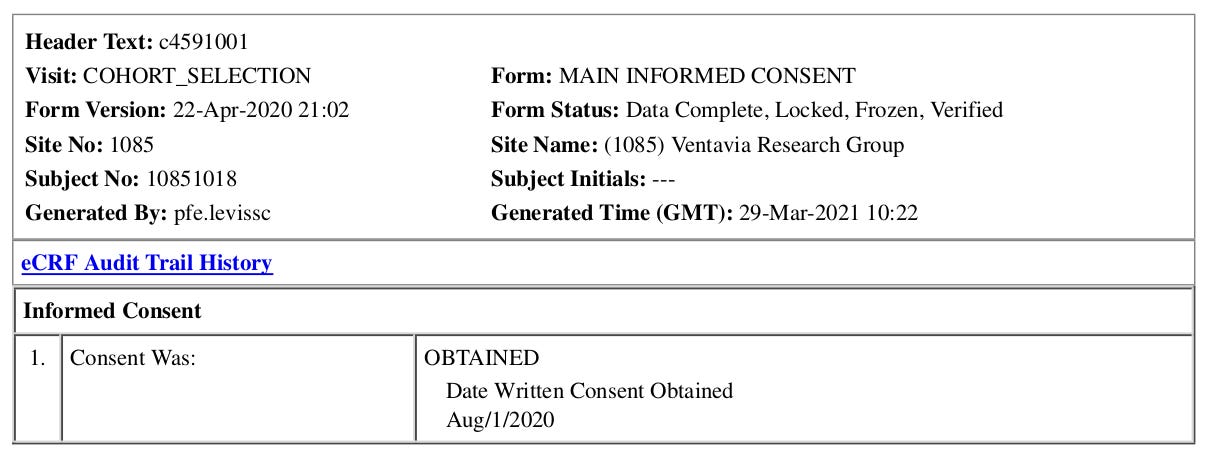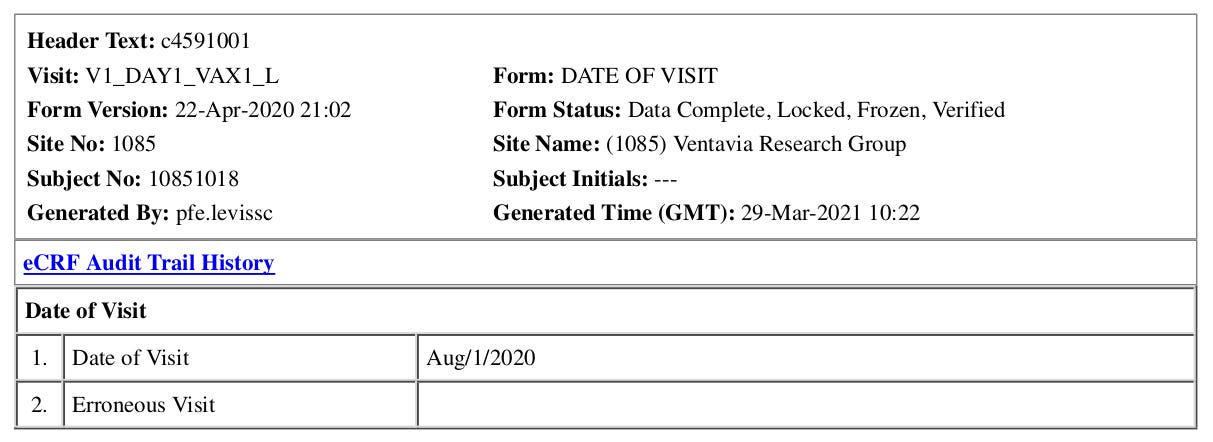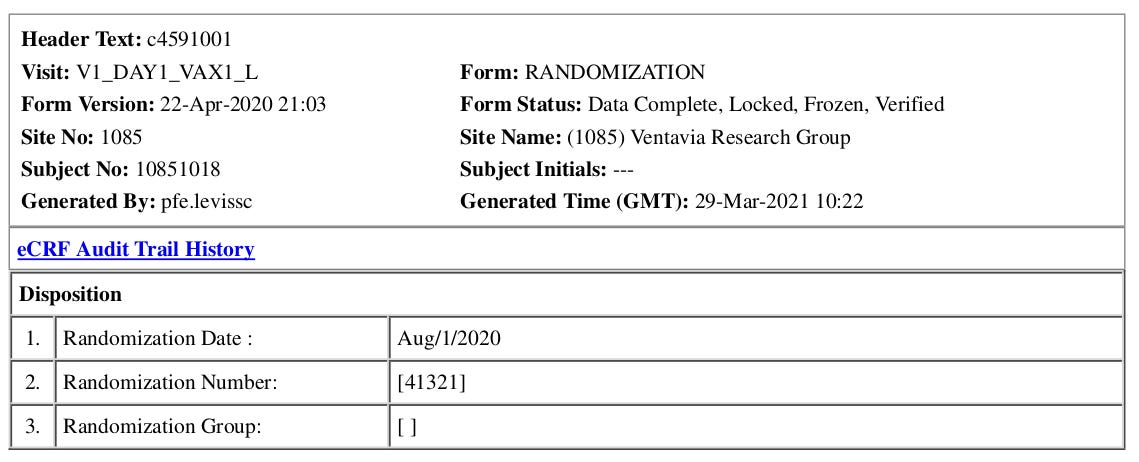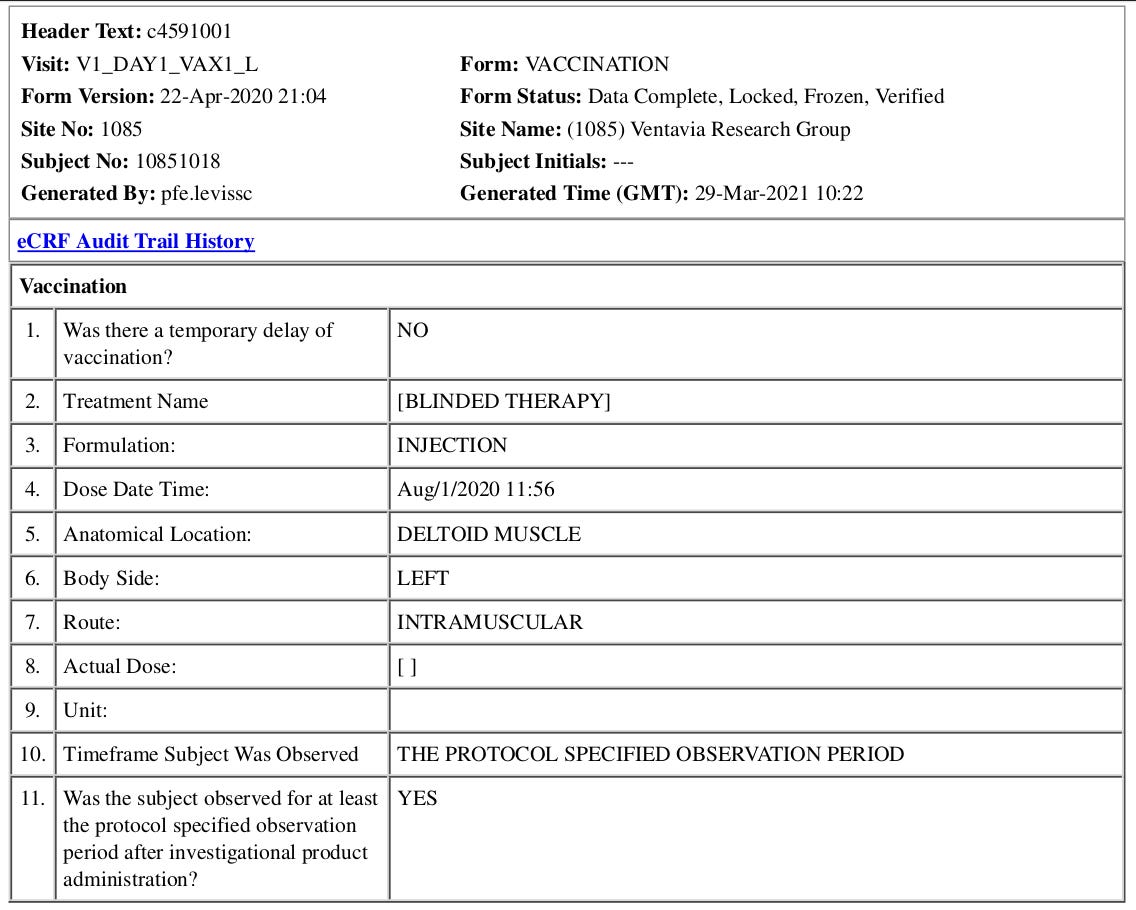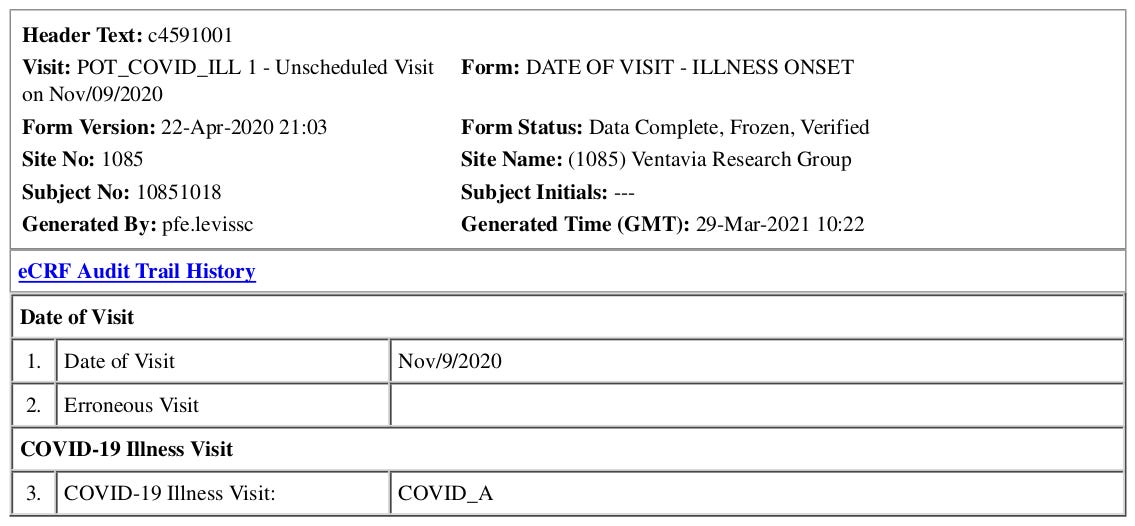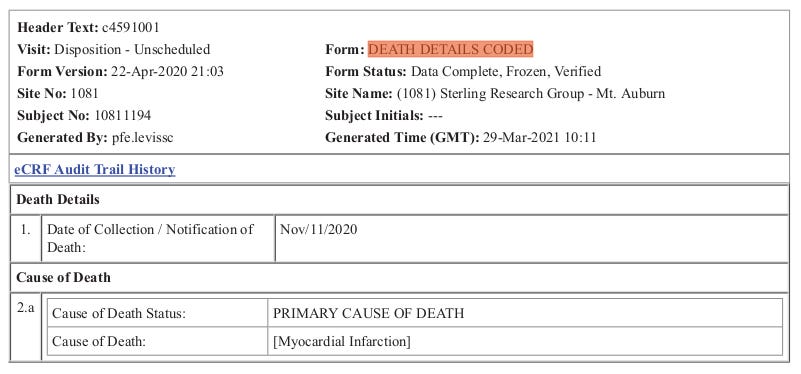Pfizer Docs Part 6: Case Report Forms
These have an incredibly low ratio of information vs. number of pages. Yes, I mean they're really long but say very little.
Today we’re taking a quick look at Case Report Forms (CRFs). If you read all the posts in this series, you already know the first document dump included 52 participant records (spread among nine pdf files). Each of these records contains all of the CRFs for that participant, and averaging about 250 pages each they contain surprisingly little information.
As an example we’re going to look at file 125742_S1_M5_CRF_c4591001-1085-10851018.pdf, which contains one record - for subject 1018, at site 1085 (run by Ventavia Research Group) - and is 423 pages long.
What’s in each participant’s record?
Pfizer uses an electronic system to track the study participants (called “subjects” in this system) and the data is organized around “visits” that occur during the study. Some of these are planned visits, some are unplanned visits, and a few are not actual physical visits but data entry activities. If you read the previous post on the Protocol for the study, you already know there are six planned visits for each participant.
Information from each visit is entered in the system in a set of Forms (CRFs), and each participant record submitted to the FDA is a printout of all the Forms in that record.
Each Form can be one or more pages and has one or more questions that require responses. There is a header repeated on every page, but only a small number of responses are entered per Form - so each page contains only a small amount of information (sometimes nothing more than a single item like a date). This means when this is all printed out it takes a lot of pages.
There are three groups of Forms in the file, in order:
Forms for entering visit related data
Comments for those Forms
Change history for each of those Forms
Not every Form has a corresponding comment Form. In our sample file, for visit V2_VAX2_L there are all three Forms for one of the activities:
LAB URINALYSIS - PREGNANCY TEST (page 23)
LAB URINALYSIS - PREGNANCY TEST – Comments (pages 110-118)
LAB URINALYSIS - PREGNANCY TEST - eCRF Audit Trail History Pages 322-323)
What’s a change history?
The system keeps track of all changes made to the data in the Forms, which Pfizer calls the “eCRF Audit Trail History.” If a Form has not yet been used then there’s no Audit Trail History Form corresponding to that Form. The Audit Trail History is created the first time a Form has data input, and is marked “Initial Entry.”
After that, any changes made to any entries are recorded along with the user making the change and the reason for the change. This means we can see the original data entered as well as every change made to that data.
Time to look at our sample file
Once again, our sample is 125742_S1_M5_CRF_c4591001-1085-10851018.pdf. This file can be viewed as three sections:
Pages 1-109 are the data Forms
Pages 110-253 are the Comments
Pages 254-423 are the Audit Trail History
Here are the main contents of the first page (which is also the first Form):
This is the COHORT_SELECTION visit (which is not a physical visit, just entry of initial data about the participant) and the first form is the COHORT SELECTION form.
Since we’ve reviewed some of the other documents, we already know what things like the study number, site number and subject number mean. Some of the others are easy to figure out:
Generated Time (GMT): 29-March-2021 10:22 - This is probably the date and time this record was generated (printed) from Pfizer’s system.
Generated By: pfe.levissc - This is the user who generated (printed) this record from the system, so probably someone involved in preparing the Biologics License Application. This is not the person who entered the data in the Forms.
Form Version: 30-Jul-2020 21:29 - it looks like Pfizer keeps track of the version number of each Form using a date. This is not the date this Form was filled out, it’s the date the Form was created or last modified.
Form Status: Data Complete, Locked, Frozen, Verified - We can only really guess at this one, but it looks like some document control information.
After the header, we get the actual information entered on this Form. For the COHORT SELECTION, there were two questions to answer - the version of the study protocol (referred to by date) and the cohort to which this participant belongs (STAGE 3 COHORTS). Remember this is a phase 1/2/3 study - stage 3 is the same as phase 3, so this is one of the almost 44,000 phase 3 participants.
Now we can look at the Audit Trail History for this Form (page 256) to see who entered the data and when. Both are marked as “Initial Entry” and have not been changed since.
The next Form is on page 2 and is still from the same visit. This Form records the informed consent of the participant, obtained on 1 August 2020.
The last Form for this visit records the demographic data for this participant, and includes a redaction. Part of the birth date is removed, most likely to maintain the participant’s privacy.
Visit 1
After that comes the first official visit (still the same day, but we’re past the introductory info now). This is Visit V1_DAY1_VAX1_L, and the first Form records the date of the visit.
The next several pages contain Forms for medical background information, vital signs collected, and other info. This Form tells us the randomization number (used to blind the study).
Finally on page 17 we get the VACCINATION Form and we can see the subject was administered an injection in the left deltoid muscle. Whether this is the vaccine candidate or the placebo is blinded.
The last Form confirms that the e-dairy for this participant was collected, and Visit 1 is complete.
Visit 2
The next visit (V2_VAX2_L) occurred on 22 August 2020, as we learn from the DATE OF VISIT Form.
The next several pages are Forms for recording things like vital signs, potential symptoms, etc.
Then the subject received the second dose, three weeks after the first dose (which per Protocol C4591001 is the recommended interval between the two doses). Once again this is recorded on the VACCINATION Form and this visit is complete.
Visit 3
This visit is one month after the 2nd vaccination, as per Protocol C4591001.
This Form records the taking of blood samples to be tested for immune response, and gives us the sample IDs.
Visit 4
The six month follow up visit occurs on 9 March 2020, and another blood sample is taken.
Visit 5
Visit 5 is the 12 month follow up, which obviously hasn’t occurred yet (it should be around 22 August 2021, which is 12 months after the 2nd vaccination). There is a placeholder in the “Date of Visit” box - this box probably requires a response and can’t be left blank.
Visit 6
Just like visit 5, visit 6 hasn’t occurred yet but should be around 22 August 2022.
First unscheduled visit
The record contains some unscheduled visits. In this case, the participant was suspected of having COVID-19 so came in for testing on 9 November 2020 and a nasal swab was collected. This is the first Form for that visit:
The symptoms were muscle pain and a sore throat, which we can see on page 37. Although a nasal swab was taken, no diagnosis was made for COVID-19.
Second unscheduled visit
The participant was back on 8 December 2020:
And blood samples were taken:
Cancelled, unscheduled visit
The participant had some kind of reaction after the first dose and scheduled a visit for 8 August but cancelled because the reaction was no longer present.
Some blank forms
And finally, pages 77-101 appear to be blank forms. We’ll need to look at another file to see if they all contain the same blank forms.
Why is this all such a mess?
This file isn’t really intended for viewing on printed pages like we’re doing. It’s an electronic system but we don’t have the software that Pfizer uses to enter and view the data (and neither does the FDA).
The software has a mechanism to output the data - print every screen from the participant’s record. This gives us 423 pages to provide information that could be summarized in just a few pages.
Conclusion
There should be about 44,000 of these records, and if they average 250 pages each there are 11 million pages of records. This first document dump only included 52 participant records and they total 13,037 pages (more than half the page count of what we have seen so far).
We don’t know why we received these particular 52 records - maybe the FDA only required a small number of sample records, or maybe later document dumps will contain the other records, and this is the reason the expected total page count for the FOIA request is so high.
If any of the study participants had severe adverse events they will be in these records. For example, in the file 125742_S1_M5_CRF_c4591001-1085-10851116.pdf there is an adverse event (acute kidney injury) listed on the ADVERSE EVENT REPORT Form on page 48.
Since we’ve now learned now to read these records, we have a better chance of finding something important in all those pages.
Here’s an example - since we know the name of the Form on which deaths are recorded, we can search for just that form in each pdf file. Taking file CRFs-for-site-1081.pdf and searching for “DEATH DETAILS CODED” gives us all the Forms with death details. On page 3123 we find out that subject 10811194 died from a myocardial infarction:
That’s it for now - when more of these records are available you now know how to quickly search them for adverse events and deaths.
Addendum to Part 6:
After reviewing the CRFs, I realized there was another way to visualize the participant records. I created an Addendum, so if you want even more info on CRFs and participant records, click here:
Otherwise, to proceed to Part 7 click here:
Or start at the beginning:



